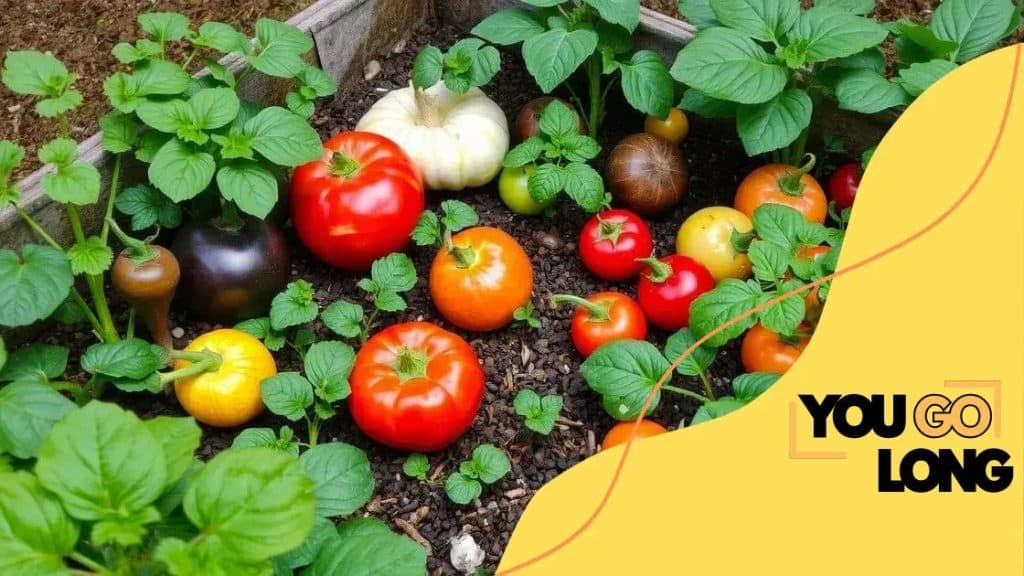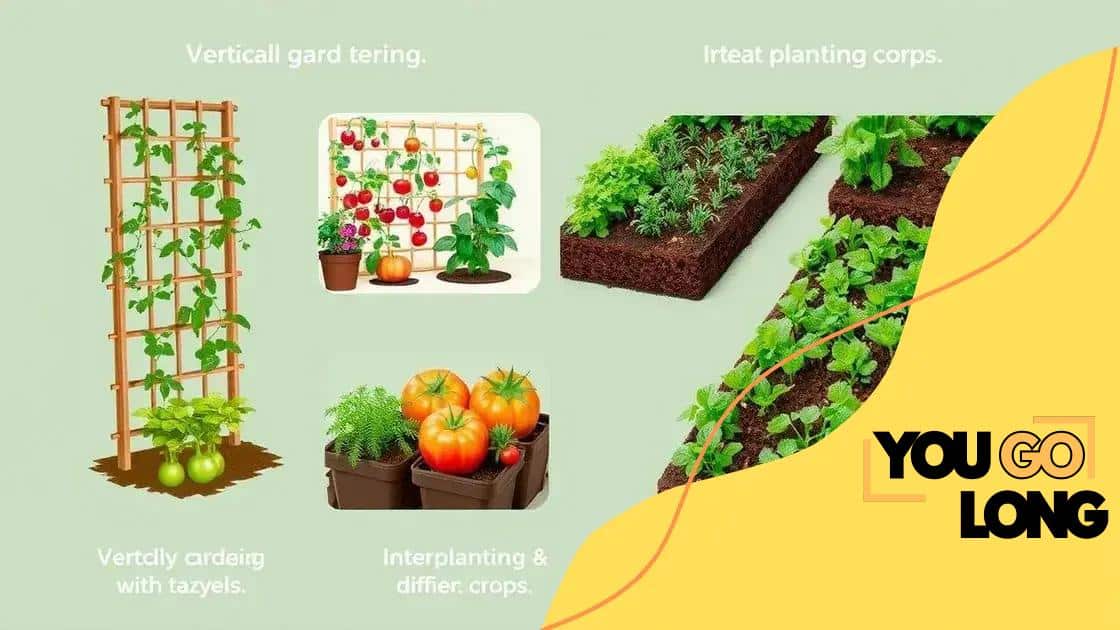How to grow your own vegetables in small garden spaces

Advertisement
Growing your own vegetables in small garden spaces is achievable through techniques like container gardening, vertical planting, and regular soil management, ensuring you maximize yield effectively.
How to grow your own vegetables in small garden spaces is a question many aspiring gardeners ask. With limited space, it can feel daunting, but it’s definitely doable! Imagine stepping outside to harvest fresh tomatoes or crisp lettuce from your backyard.
Choosing the right vegetables for small spaces
Choosing the right vegetables is crucial when cultivating a garden in small spaces. Not all plants thrive in limited areas, so selecting the right varieties can make a big difference.
Best Vegetables for Small Gardens
Some vegetables are particularly well-suited for smaller gardens because they grow compactly. For instance, consider planting:
Advertisement
- Cherry tomatoes – These small fruits grow well in pots and can produce large yields.
- Radishes – Quick to grow and require minimal space, making them perfect for small areas.
- Green beans – They can climb trellises, utilizing vertical space instead of ground area.
- Lettuce – Leafy greens can be harvested continually, giving you fresh salads over time.
Additionally, think about your local climate and growing conditions, as these factors will significantly influence your choice. For example, some plants prefer cooler weather, while others thrive in the heat. It’s wise to choose vegetables that will grow successfully in your specific environment.
Companion Planting
When deciding on vegetables, consider companion planting. Certain plants can benefit each other when grown together, helping maximize your space. For instance:
- Tomatoes grow well with basil, which can enhance growth and flavor.
- Carrots thrive alongside onions, which can help keep pests away.
- Marigolds can repel harmful insects, aiding surrounding vegetables.
By selecting the right combinations of plants, you’ll ensure a more productive and healthy garden. Remember, even in a small space, thoughtful planning can yield a bountiful harvest. Happy gardening!
Advertisement
Essential tools for small garden success
Having the right tools is essential for small garden success. These tools can make your gardening experience easier and more efficient. When space is limited, choosing versatile and compact tools is key to making the most of your garden.
Must-Have Tools for Small Gardens
Here are some essential tools that every small gardener should consider:
- Hand trowel – Perfect for digging small holes and transplanting seedlings without taking up much space.
- Pruning shears – These are vital for trimming plants and promoting healthy growth.
- Garden fork – Great for loosening soil and mixing compost into garden beds.
- Watering can – An easy way to provide water without disturbing your small garden. Choose one that is lightweight and has a narrow spout.
With these tools, you can effectively prepare your soil, manage your plants, and maintain your garden’s health. Remember to keep your tools clean and stored properly to prolong their life and utility.
Additional Helpful Tools
In addition to the essentials, consider adding a few more tools to enhance your gardening experience:
- Garden gloves – Protect your hands while working with soil and plants.
- Flexible garden hose – Ideal for small spaces, easily reaches all areas without becoming cumbersome.
- Seedling trays – Excellent for starting seeds indoors or in limited outdoor spaces.
Investing in these tools will pay off in the form of reduced effort and improved results. A well-equipped gardener is more likely to see the fruits of their labor flourish, even in a small garden. So, gear up, and let your garden thrive!
Techniques for maximizing yield and space

Using effective techniques can greatly enhance both the yield and space efficiency of your small garden. By implementing smart strategies, you can enjoy a bountiful harvest even in limited areas.
Vertical Gardening
One of the best ways to maximize space is through vertical gardening. This method involves growing plants upwards instead of outwards. You can use walls, trellises, or shelves to support climbing plants. Some great options for vertical gardening include:
- Cucumbers – These can easily climb trellises, saving ground space.
- Peas – Another climbing variety that thrives in smaller gardens.
- Climbing beans – They grow quickly and can cover vertical structures.
Vertical gardening not only saves space but also improves air circulation around your plants, helping to prevent diseases.
Interplanting
Another effective technique is interplanting, which involves growing different crops in close proximity. This method can lead to better use of nutrients and space. For example, planting lettuce between tomato plants allows you to maximize your garden’s yield.
Interplanting also helps in pest management, as certain combinations can deter pests naturally. However, it’s essential to research which plants grow well together.
Succession Planting
Consider using succession planting to ensure a continuous harvest. This method involves planting new crops as soon as the previous ones are harvested. For instance, after you harvest early lettuce, you can immediately plant beans or radishes in the same space. This practice keeps your garden productive throughout the growing season.
Effective use of spacing is also critical. Make sure to follow the recommended spacing guidelines for each plant to avoid overcrowding. Proper spacing ensures that each plant gets enough sunlight, water, and nutrients, ultimately leading to better growth and higher yields. Implement these techniques to get the most out of your small garden.
Maintaining your vegetable garden throughout the season
Maintaining your vegetable garden throughout the season is vital for ensuring healthy plants and a good harvest. Each season brings unique tasks that help you care for your garden effectively.
Regular Watering
Consistent watering is crucial in keeping your vegetables thriving. During hot days, your plants might need water more frequently. It is best to water in the morning, allowing plants to absorb moisture before the heat of the day. Ensure the soil remains damp but not soggy. Adjust the watering schedule based on the vegetables you are growing, as some require more water than others.
Pest Control Methods
Keeping your garden free from pests is essential for plant health. Regularly check your plants for signs of pests, such as holes in the leaves or visible insects. Here are some effective pest control methods:
- Handpicking – Remove pests like slugs and beetles by hand.
- Natural sprays – Use soap sprays or neem oil to deter pests.
- Companion planting – Certain plants can help repel pests naturally when grown together.
By implementing these methods, you can protect your crops without the need for harsh chemicals.
Weed Management
Weeds can compete with your vegetables for nutrients and water. Regular weeding is essential for maintaining your garden’s health. It is helpful to check your garden weekly and remove any emerging weeds by hand or with a hoe. You can also mulch around your plants to suppress weed growth and retain soil moisture.
Fertilizing and Soil Health
Ensuring your soil remains fertile is key to a productive vegetable garden. Use organic fertilizers, such as compost or well-rotted manure, to enrich your soil. Regularly test your soil to understand its nutrient levels and pH balance. Adjust fertilizer application based on the needs of your plants. Proper soil health not only boosts plant growth but also helps resist diseases.
As the seasons change, be sure to observe your plants closely and adjust your care routines accordingly. Seasonal changes may require new strategies or additional tasks, but paying attention to your garden’s needs can help you enjoy a fruitful harvest.
Common challenges and solutions for small gardeners
Gardening in small spaces comes with its own set of challenges. However, understanding these obstacles can help you find effective solutions to achieve a thriving garden.
Limited Space
One major challenge small gardeners face is limited space. It can be hard to decide how to fit all your desired plants into a small area. To address this, consider container gardening. Using pots allows you to grow vegetables, herbs, and flowers in almost any environment. You can also implement vertical gardening techniques, which help maximize space by growing plants upwards instead of outwards.
Pest Management
Pests can quickly become a problem, especially in small gardens. With fewer plants, it’s easier for pests to invade and damage crops. To combat this, you can apply natural pest control methods such as:
- Diatomaceous earth – A natural powder that can help deter soft-bodied insects.
- Companion planting – Growing certain plants together can help repel pests naturally.
- Regular inspections – Check your plants for pests frequently to catch any issues early.
By being proactive, you can minimize pest effects and maintain plant health.
Soil Quality
Another challenge is ensuring you have high-quality soil. Poor soil can lead to weak plants that struggle to grow. Invest in organic compost to enhance soil fertility and structure. Regularly testing your soil can also help you understand its nutrient composition. This way, you can amend it accordingly to support your plants’ growth.
Watering Issues
Watering can become tricky in small gardens. It’s essential to provide enough moisture without overwatering. Utilizing a drip irrigation system can help deliver precise amounts of water directly to the plant roots. Also, consider using self-watering pots that provide a consistent moisture level. If you are not able to water regularly, setting a schedule can help ensure your plants remain hydrated.
Maintaining Crop Rotation
In a small space, maintaining crop rotation can feel challenging. However, rotating your crops is vital in preventing soil-borne diseases and nutrient depletion. To successfully implement rotation, plan your garden layout in advance. Use different areas for planting various vegetable families each season, which will help improve overall soil health and productivity.
By recognizing these common challenges and implementing practical solutions, small gardeners can foster a productive and healthy gardening environment.
FAQ – Common Questions About Small Vegetable Gardening
What are the best vegetables to grow in a small garden?
Some great options include cherry tomatoes, lettuce, and radishes, as they thrive in limited space and yield a good harvest.
How can I control pests in my small garden?
You can use natural pest control methods such as handpicking pests, using organic sprays, and planting companion plants that deter insects.
What techniques can help maximize space in a small garden?
Implement vertical gardening, use container gardening, and practice interplanting to make the best use of your available space.
How often should I water my small garden?
Generally, it’s best to water your garden in the morning and check the soil moisture regularly. Adjust frequency based on weather and plant needs.





